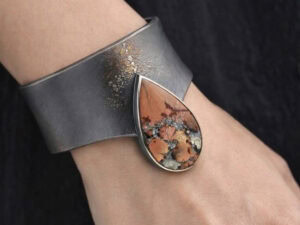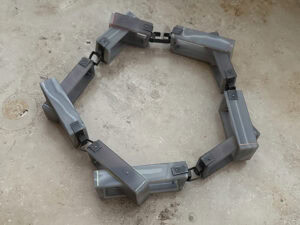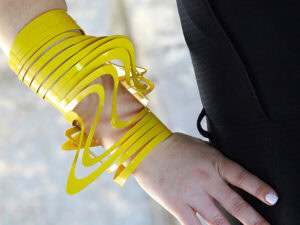In 2008, Ruudt Peters gave a lecture at SOFA Chicago titled ‘Philosopher’s Stone.’ This lecture was sponsored by AJF. He used imagery and terminology from the medieval practice of alchemy that attempted to turn base metals into gold.
Peters explained he was a member of the Dutch generation of artists who began working in the 1970s, when he and his peers explored a variety of materials to make jewelry, refusing to work with the traditional gold and silver or precious stones. Instead, they used materials like aluminum and rubber to create necklaces and bracelets. As he described his work over the years, he talked about what inspired him, what he then created and how he presented his work. As he followed this cycle of inspiration, creation and presentation, he produced an eclectic, varied, and beautiful body of work.
While he creates amazing and wonderful jewelry, he consistently raises the bar (and, perhaps, an eyebrow or two) in the way he presents his work. For example, at SOFA Chicago, Peters’s brooches from the series called Azoth (The Philosopher’s Stone) – featuring layers of multicolored polyester surrounding a black, oxidized hollow silver core – were presented submerged in individual bowls/tanks of water anchored on tall, metal stands, so the viewer could see the work about waist high. Peters noted the water worked as a magnifier of the jewelry. (There were not many hands plunging in without permission, either!) This installation was featured at Ornamentum Gallery, which is owned by AJF members Laura Lapachin and her husband Stefan Friedemann. Peters acknowledged that he doesn’t present his work in a way that makes it easy for the viewer to touch. He wants you to approach with respect. He showed examples of previous installations where his jewelry was hidden behind gauze netting tents, or nestled in little pillows under a lamp, looking just like a nursery setting (‘They’re my babies’) or in laboratory vials.
And while Peters now does use precious materials in his work, he’s likely to hide it, for example, by covering silver with layers of polyester, which rub off as the jewelry is worn, revealing the more precious layer over time.
In closing, here’s how Peters expresses his own philosophy: ‘Every piece of jewelry conceals what it adorns. Jewelry is highly communicative, you have to come close to experience it. And yet, If you grasp at things desirously, they will retreat.’




